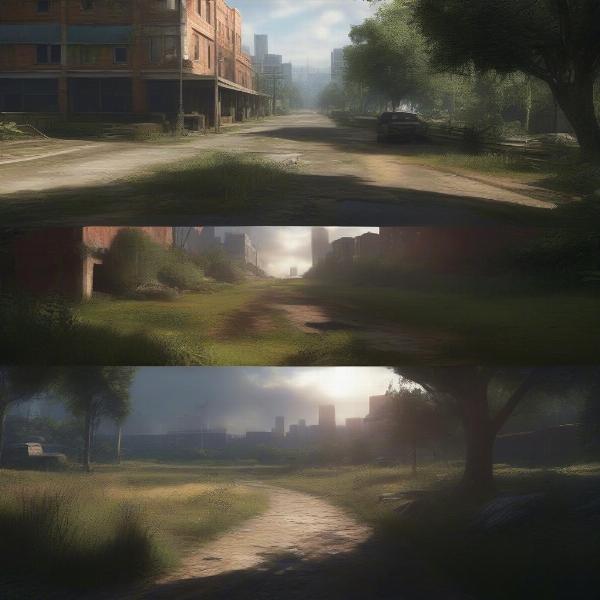The Last of Us, a critically acclaimed masterpiece, often sparks debate among gamers: Is The Last Of Us An Open World Game? The short answer is no, but it’s more nuanced than a simple yes or no. Let’s delve into the game’s level design and explore why this question arises so frequently.
After the initial outbreak in The Last of Us, you find yourself navigating a post-apocalyptic world, encountering various environments, from overgrown cities to desolate suburbs. The game encourages exploration, allowing players to scavenge for resources, uncover hidden stories, and immerse themselves in the decaying beauty of the world. This sense of freedom often leads players to believe they’re experiencing an open-world environment. However, The Last of Us utilizes a more linear, “wide-linear” structure. While offering some open areas for exploration, the game ultimately guides you along a predetermined path.
Understanding The Last of Us’s Level Design
The Last of Us doesn’t offer the boundless freedom of a true open-world game like, for example, those in the Fallout series. Instead, it presents a series of interconnected levels, often with multiple pathways to reach your objective. This “wide-linear” approach strikes a balance between directed storytelling and player agency. You can venture off the main path to discover optional areas, collectibles, and resources, adding depth to the gameplay experience. For fans of the Fallout franchise, exploring the various games’ open-world settings can be a great way to understand the difference in scope. You might be interested in learning which Fallout game to play first.
This approach fosters a sense of discovery and allows players to immerse themselves in the environment. You can choose to meticulously search every nook and cranny or stick to the critical path, shaping your experience according to your playstyle. The game encourages exploration by rewarding curiosity with valuable resources and narrative snippets, deepening the player’s connection to the world and characters.
 The Last of Us Wide Linear Gameplay
The Last of Us Wide Linear Gameplay
Comparing The Last of Us to Other Game Structures
To further understand why The Last of Us isn’t classified as open world, let’s compare it to other game structures. Traditional linear games offer a single, predetermined path with little to no deviation. Open-world games, on the other hand, provide vast, seamless maps where players can explore freely, completing objectives in any order. The Last of Us falls somewhere in between. While not as restrictive as a purely linear game, it lacks the open-ended nature of true open-world titles. Similarly, considering whether a game like Infinite Wealth is the last in a series, such as the Yakuza franchise, highlights the diverse approaches to game development and storytelling. You can learn more about the speculation surrounding Infinite Wealth and its potential place as the last Yakuza game.
This “wide-linear” approach allows the developers to craft a more focused narrative while still offering players a sense of exploration and agency. It’s a deliberate design choice that prioritizes storytelling and emotional impact, elements crucial to The Last of Us’s success. The structure contributes to the narrative’s tension and emotional depth by controlling the pacing and guiding the player through carefully crafted set pieces and environmental storytelling.
 The Last of Us vs Open World Comparison
The Last of Us vs Open World Comparison
Is The Last Of Us Part II Open World?
The Last of Us Part II expands upon the first game’s level design, offering larger, more open areas for exploration. While still not a fully open-world game, Part II provides more freedom to explore, scavenge for resources, and engage in optional encounters. Certain sections, particularly in Seattle, give players more agency in choosing their path and approach. This evolution in level design caters to players seeking a greater sense of exploration while maintaining the series’ core focus on narrative. The shift towards larger, more explorable environments in Part II sparked numerous discussions amongst players, prompting them to ask “is the last of us an open world game?” even more.
However, it’s important to note that Part II, like its predecessor, still adheres to a largely linear narrative structure. The increased freedom within levels enhances gameplay and player agency but doesn’t transform the game into a true open-world experience. For example, you might be wondering if you can watch a specific sporting event on television, similar to queries about whether the Texas game is on TV. This type of question highlights the different ways people seek information and entertainment.
“The Last of Us series expertly uses environmental storytelling to create a deeply immersive experience,” notes game designer Emily Carter. “While not open world, the level design cleverly guides the player, encouraging them to explore and uncover the narrative woven into the world.”
 The Last of Us Part II Exploration
The Last of Us Part II Exploration
Related Game Design Concepts: Open World vs. Linear
Beyond the specific case of The Last of Us, it’s valuable to explore the broader concepts of open world versus linear game design. Linear games offer a carefully curated experience, guiding the player through a predetermined narrative. Open-world games provide freedom and player agency, allowing for emergent gameplay and exploration. Many families enjoy playing games together, and you might be interested in playing “Do You Really Know Your Family?” online to strengthen your bonds. Each structure has its own strengths and weaknesses, and the choice ultimately depends on the game’s intended experience. Understanding the nuances of these design choices can deepen your appreciation for game development and the decisions that shape the games we play. Much like wondering when a major event like the SEC Championship Game will occur, anticipating and speculating about game design features adds to the excitement of the gaming community. You can find out when the SEC Championship Game 2023 is scheduled.
Conclusion
So, is The Last of Us an open world game? No, but its unique “wide-linear” structure provides a compelling blend of narrative focus and player exploration. This design choice allows The Last of Us to deliver a powerful, emotionally resonant story while still offering a rewarding sense of discovery. While the series offers larger, more explorable areas in its later installments, the core design philosophy remains. Ultimately, The Last of Us exemplifies how a carefully crafted linear experience can be just as captivating as a vast open world.
FAQ
-
What is a wide-linear game?
A wide-linear game blends linear storytelling with open areas for exploration, providing a balance between directed narrative and player freedom. -
Does The Last of Us Part II have bigger maps than the first game?
Yes, The Last of Us Part II features larger, more open environments, particularly in the Seattle sections. -
Why isn’t The Last of Us considered open world?
The Last of Us follows a predetermined narrative path, unlike true open-world games that allow for unrestricted exploration and objective completion in any order. -
What are the advantages of a linear game structure?
Linear games allow developers to craft a focused narrative experience with tighter pacing and emotional impact. -
What are some examples of true open-world games?
Games like Grand Theft Auto V, The Witcher 3: Wild Hunt, and The Legend of Zelda: Breath of the Wild are examples of true open-world games. -
What is the difference between linear and open world games?
Linear games follow a set path, while open-world games offer vast, explorable environments with greater player freedom. -
How does The Last of Us encourage exploration within its linear structure?
The Last of Us rewards exploration with valuable resources, narrative snippets, and hidden areas, enhancing immersion and player agency.

